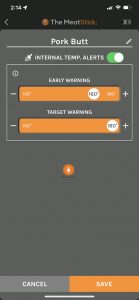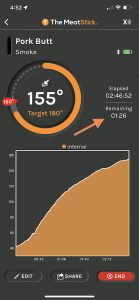This article will teach you where to probe a brisket using a meat thermometer to get accurate internal temperature readings, hit crucial target temperatures during the cooking process, and get delicious brisket on every cook.
When it comes to BBQ food, smoked whole brisket is one of the most prized meats. It can be a little tricky to smoke properly, but with good techniques and proper temperature monitoring, you can cook one like a pro too.
Knowing where to probe the brisket, how, and why, will help you get better and more consistent results.
Where to Insert a Temperature Probe in a Brisket
Where to probe a brisket is an important question. The best place to probe a brisket is in the thickest part of the meat, away from the fat. You want to make sure the probe is in the center of the densest part of the brisket, which is typically between where the point and the brisket flat meet.
The point is the fattier area of the brisket, and it’s important to avoid probing this area when taking temperature readings. The probe can easily slip into the fat and give you an inaccurate reading. When probing the point, be sure to stick the probe in at an angle so that it’s not touching any of the fat.
The flat is the leaner area of the brisket and is a little easier to probe. However, you still want to make sure you’re in the densest part of the flat when taking temperature readings.
Below is a helpful diagram showing you where to insert the temperature probe.

How to insert the probe into the brisket
Probe the brisket from the side, not from the top. If you pierce the top of the brisket, all of the juices will run out, and your brisket will be dry. Pierce the side of the brisket about halfway through with the tip of your probe.
The probe should go in at a 45-degree angle towards the center of the brisket. Insert the probe until it reaches the center of the brisket. If you insert it too far, you’ll puncture the other side of the brisket and all of the juices will run out.
Probing Brisket Techniques using different thermometers
When using an analog meat thermometer, insert the probe into the densest part of the brisket at an angle, making sure not to touch any fat. Insert the probe until only the metal tip is no longer visible, or about half the total length of the probe. Some manufacturers have different instructions, so be sure to check your thermometer’s manual.
Analog meat thermometers are the most common type of meat thermometer, and they’re what most people think of when they think of a meat thermometer. They’re simple to use and relatively inexpensive, making them a great option for beginners.
Digital meat thermometers or digital instant-read thermometers are a different option. These thermometers usually have a metal probe with a digital display. To use one, simply insert the probe into the thickest part of the brisket at an angle, making sure not to touch any fat. As their name implies, these thermometers give you temperature readings instantly.
If the brisket is not at temperature, continue cooking and check again later.
You might also like:
Brisket Cook Times per Pound, Explained
You cannot leave instant-read thermometers in the brisket while cooking, as they will give you inaccurate readings and get damaged. Instead, check the temperature every 30-60 minutes.
If you want to monitor cooking and internal temperatures while relaxing and enjoying a drink, that’s when wireless thermometers come in. Wireless thermometers eliminate a lot of the guesswork and the need to constantly open and close your smoker every few minutes to check the brisket. You can also set alarms and reminders to make sure you hit critical target temps with accuracy. Like Aaron Franklin says, ” If you are looking, you ain’t cooking!”
The technique for probing and brisket with a wireless thermometer is a bit different but still comprises of the same basic principles. The difference is number one, you will leave the meat probe inside the meat, remember away from brisket fat, and number two, you will need to pair the thermometer with your mobile phone, or with some Bluetooth thermometers, you will use a remote display to monitor the temperature.
When to Probe Brisket
The answer to this question varies depending on the size of the brisket. A general rule of thumb is to start checking the temperature and begin probing the brisket after it has been cooking for at least three hours. Of course, this can change based on the brisket size.
Smoking a brisket at temperatures of 225 to 250 degrees Fahrenheit requires cooking times of one to one and a half hours per pound. Therefore, for smaller briskets, you can start checking the temperature sooner.
You should start probing the brisket meat before it reaches an internal temperature of 165 degrees Fahrenheit or begins to stall. At this point, you’ll want to check the temperature every 30 minutes or so or use your smart thermometer to alert you when it is time to warp ( Texas Crutch ), if the brisket stalls, and when is done.
How deep should you insert a meat probe thermometer?
Place a thermometer in the center of the brisket and place it in a position where the meat has the highest density. Some thermometers only require the tip to be inserted or half of the probe, but others require the probe to be all the way in.
Why You need to Probe Your Brisket
You need to probe the brisket to cook it properly, to the right doneness level, and end up with juicy, tender meat. By inserting a probe into the meat, you can monitor the internal temperature and make sure that it is smoked all the way through, yet keep the meat moist.
When cooking brisket, it is important to keep an eye on the internal temperature so that you don’t overcook it or undercook it.
Tips for the cooking process:
Place a thermometer in the center area of the brisket.
Start cooking your brisket fat side down first. Let that fat cap work for you. But if you are smoking the brisket using a good pellet grill ( indirect heat ) fat side up is fine.
Set the probe in the thickest areas for an accurate reading, and set the alarm on your thermometer to notify you when the meat reaches wrapping temperatures and when it is done. Below are images of my thermometer app, I use a MeatStick.


Take it easy; take your time. If this is your first brisket, you might not get the best results, but focus on getting the internal temp right, and with some practice, you will get an amazing, tender brisket.
You can also try our “Easy Brisket” recipe with step-by-step instructions.
How do I know when my brisket is done?
Brisket is a tough cut of meat that benefits from slow, low-temperature cooking. This cooking method breaks down the collagen and connective tissue in the meat, making it tender and juicy. However, if the brisket is overcooked, it will become dry and tough.
So how do you know when a brisket is done? The best way to gauge doneness is to use a digital thermometer and wait until the meat reaches 190 degrees. Again, don’t guess or go by the bark color, always check the meat’s temp, and you will get it right.
Conclusion
It’s important to be diligent about probing so that you don’t overcook or undercook the brisket. Remember that you want to probe or insert the meat probe in the thickest areas of a packer brisket.
Where you place your temperature thermometer will determine how accurate of a reading you get.
Enjoy the process. Enjoy grilling!





